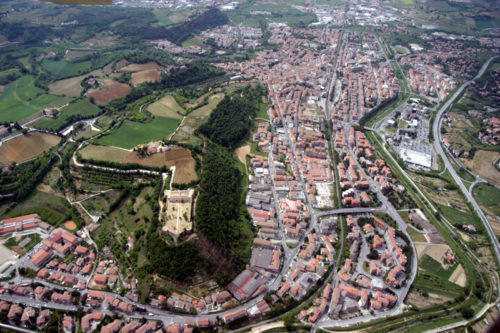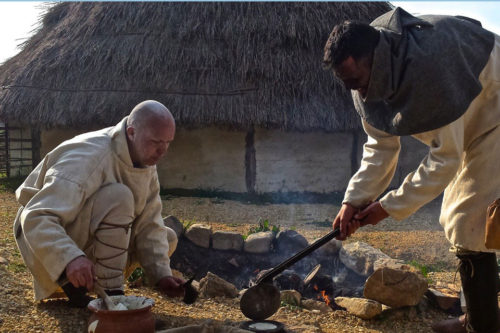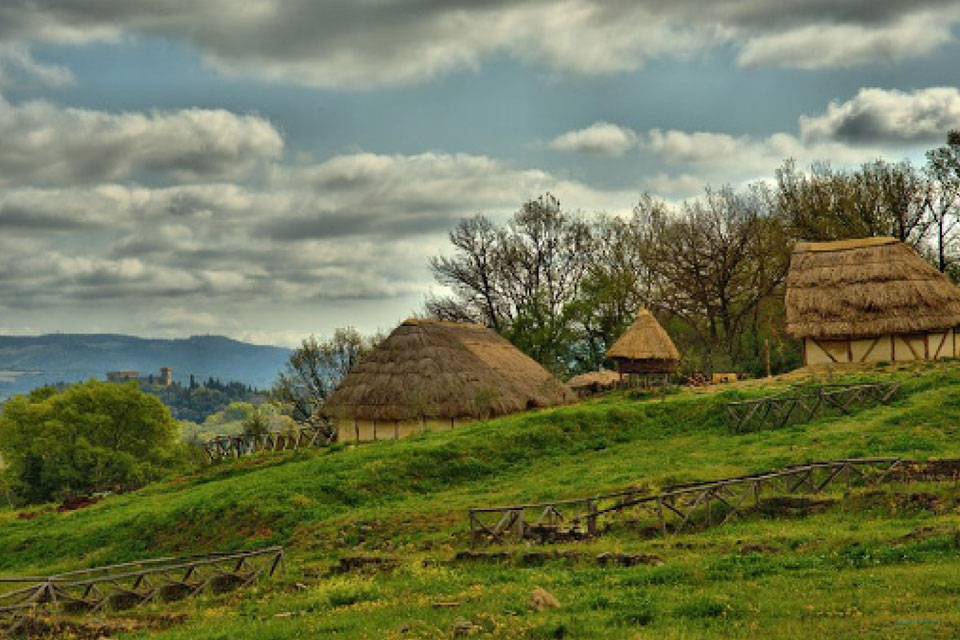Medieval Poggibonsi in Tuscany is a fortified hilltop village, which has been extensively excavated by archaeologists from Siena. Now an open-air museum, it is an initiative dedicated to authenticity and faithful recreation.

The Park at Poggibonsi is an archaeological and monumental area covering 12 ha. It holds the ruins of a settlement or hilltop village, which lay in the saddle of a hill, walled in by massive Renaissance bulwarks, remains of a castle, begun by Lorenzo il Magnifico. In the early nineties, the archaeologists, Riccard Francovich and Marco Valenti, from the University of Siena began to excavate the hilltop village at old Poggibonsi. Continued excavations succeeded in mapping a story, which reached back to the 6th century. At this time a group of people gathered together to settle at the hilltop. Whether the people were fleeing from flooding and erosion in the valley or violent attacks from marauders, or a combination of all, is not known. There is no doubt, though, that they were not the only people at this point, who took to the top of the hills in Northern and Central Italy.
This 6th-century village continued until the 9th century when the settlement shifted its character. At this point, the village became focused upon a central building, an oblong seigniorial hall in the classic Northern European form. Later, in the high middle ages, the site was once again re-planned. Now, a major church was built together with gridded streets and elegant townhouses.
Following the end of the first excavations, the area was turned into a public park. Later, a small meeting centre, as well as a trattoria and a bar, has succeeded in turning the site into a popular spot for an afternoon excursion for people living in modern Poggibonsi.
10th-Century Village

The project, though, did not end there. In 2014 a new initiative was launched to recreate the village in its 9th to 10th-century version by the Sienese Museum Foundation, the city of Poggibonsi and the University of Siena’s archaeology department. Despite some lack of funding, the first part of the village was inaugurated in the autumn of 2014. As of now, the lord’s hall has been built as well as a few other structures: a peasant hut, a hen house, a fence, and and orchard with olive- and fruitrees from the genomen bank belonging to Siena. The plan is to end up with the entire village comprising 17 buildings. Everything is reconstructed according to the scientific knowledge, which archaeologists and historians at the University of Siena have amassed since the early 90s when the first excavations took place.
However, the open-air museum is not just an archaeological experimental re-creation site; it has also been turned into a forum for active story-telling, which is considered an essential element. The centre accordingly employs full-time and voluntary re-enactors from a group called La Fara, who have been fitted out with accurate and authentic roles to play. In the long run, the aim is to make it acceptable to create links between scholars, re-enactors and living historians in such a way that heritage becomes more than a venue, but rather a habitat. On the website of the Archeodrome, the peopel in the drama are listed with portraits, and stories. Here we learn about Guido il Vecchio, who is the lord of the village, Teupala who is the saddler, Johannes who is is the carpenter, and Biancastella, who is in charge of dyes etc.
Attendance has risen markedly between 2014 and 15 – from c. 24.000 to 70.000. Also, people are staying longer. At the same time, the overnight stay in Poggibonsi has risen with more than 10% arrivals, and 16% overnight stays; a remarkable feat, since Poggibonsi – the modern city – is known as the “dirty armpit” of Tuscany. The town was razed to the earth during WW2 and usually has to live with the fact that tourists move hastily through it to get to Siena and San Gimignano.
To sum it up, writes Marco Valenti, who is active as both a medieval archaeologist and entrepreneur in the museum business, the project has served to establish a fruitful alliance between local government, researchers, communities, associations and the wider public. While the aim is to let cultural heritage play the role it deserves, it has also been good business.
SOURCES:
“We invest in Public Archaeology”. The Poggibonsi Archaeodrome Project: an Alliance between People, Municipality and University.
By Marco Valenti
In: European Journal of Post Classical Archaeologies (2016) Vol.6, pp.417-430
Living Archaeology at the Archaeodrome
By Francesco Ripanti
Archeostorie. Journal of Public Archaeology 2017
VISIT:
Archaeodromo Poggibonsi
53036 Poggibonsi, Tuscany, Italy
PLAY:
A Day in the 9th Century
Courses for would be Italian re-enactors are organised by the team behind the Carolingian Open-Air-Museum and led by Marco Valenti
LEARN:
Summer School 2017
“La materialità della storia: archeologia sperimentale e living history”
La formazione di una nuova figura di operatore dei beni culturali
19.06.2017 – 24.06.2017
READ ALSO:
